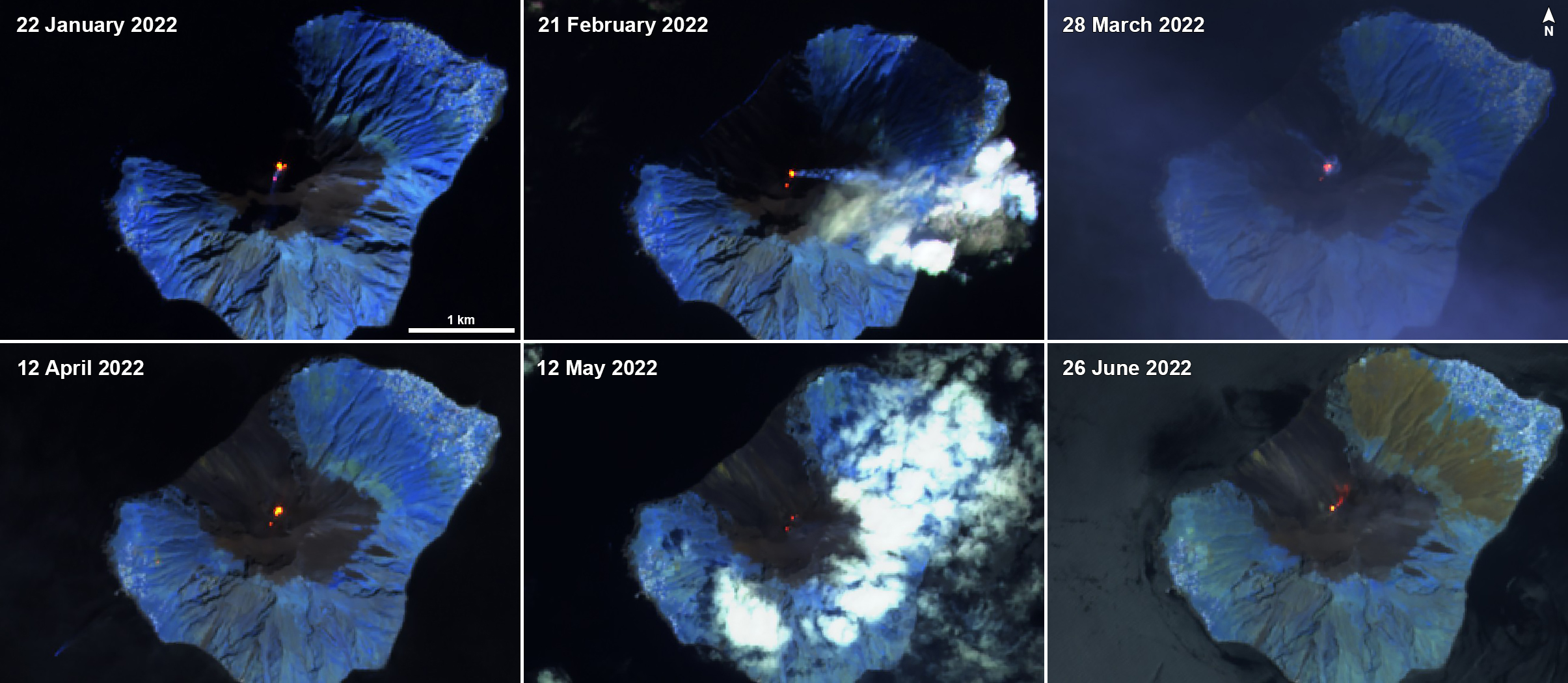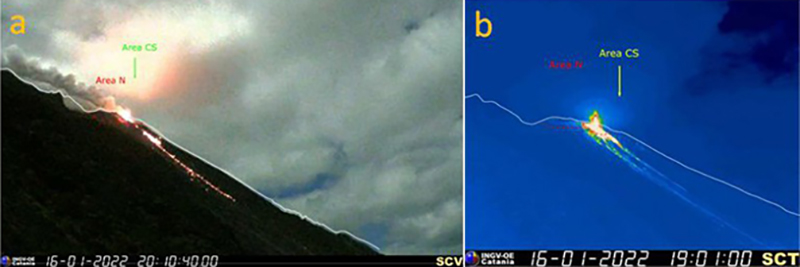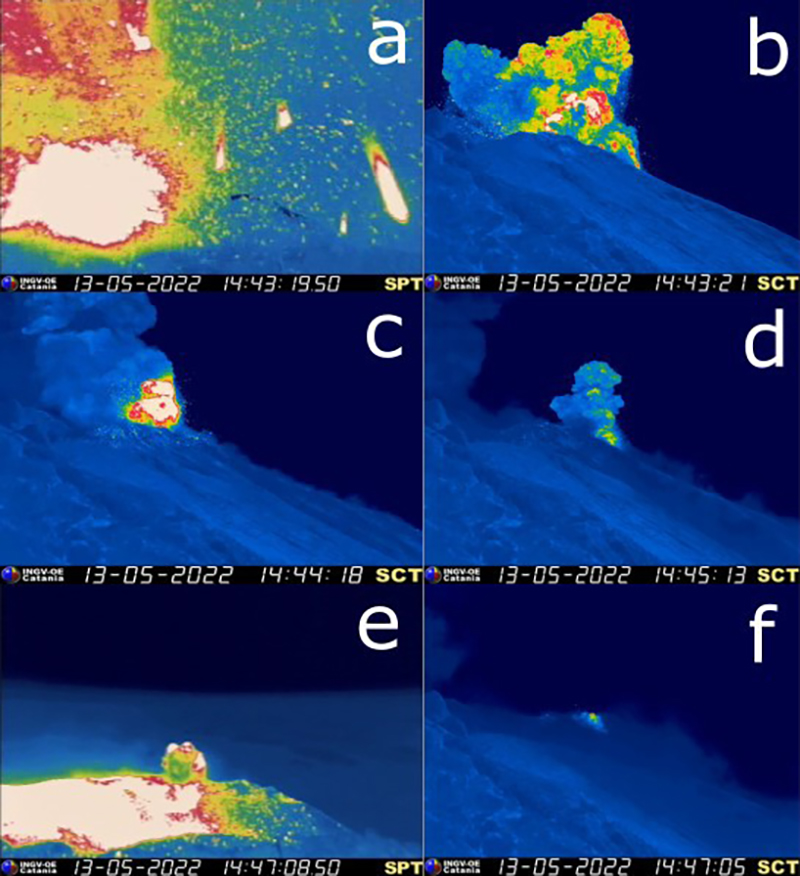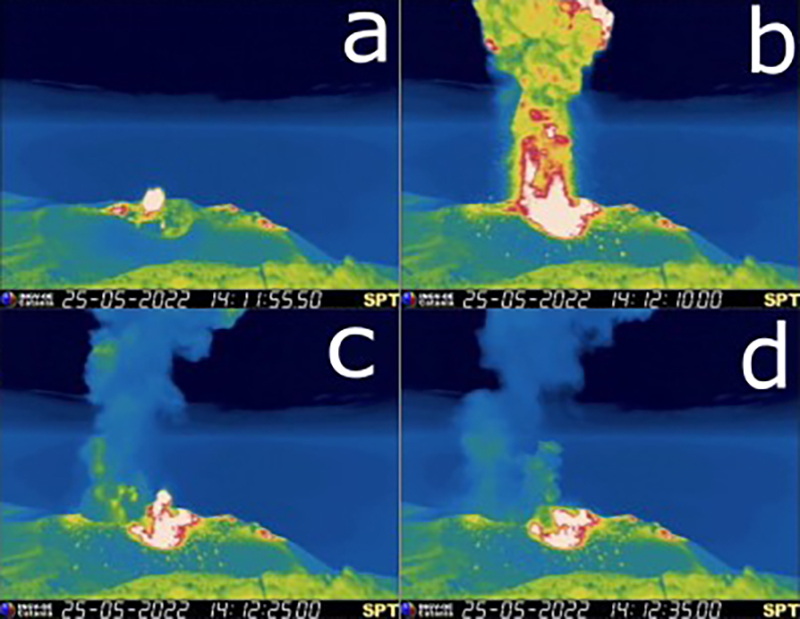Report on Stromboli (Italy) — July 2022
Bulletin of the Global Volcanism Network, vol. 47, no. 7 (July 2022)
Managing Editor: Kadie Bennis.
Stromboli (Italy) Strombolian explosions and incandescent ejecta during January-June 2022
Please cite this report as:
Global Volcanism Program, 2022. Report on Stromboli (Italy) (Bennis, K.L., ed.). Bulletin of the Global Volcanism Network, 47:7. Smithsonian Institution. https://doi.org/10.5479/si.GVP.BGVN202207-211040
Stromboli
Italy
38.789°N, 15.213°E; summit elev. 924 m
All times are local (unless otherwise noted)
Stromboli is a SE Tyrrhenian Sea stratovolcano in Italy that has exhibited nearly constant lava fountains for the past 2,000 years; recorded eruptions date back to 300 BCE. Eruptive activity occurs at the summit from multiple vents, which include a north crater area (N area) and a central-southern crater (CS area) on a terrace known as the ‘terrazza craterica’ at the head of the Sciara del Fuoco, a large scarp that runs from the summit down the NW side of the volcano-island. Activity typically consists of Strombolian explosions, incandescent ejecta, lava flows, and pyroclastic flows. Thermal and visual monitoring cameras are located on the nearby Pizzo Sopra La Fossa, above the terrazza craterica, and at multiple flank locations. This report covers activity during January through June 2022 using Italy's Istituto Nazionale di Geofisica e Vulcanologia (INGV) and various satellite data.
Stromboli continued to exhibit a range of explosive activity during January through June 2022 with a gradual decrease in the number of hourly explosions at the summit crater during April through June (figure 234, table 14). Thermal activity for this period remained relatively low, with a short spike in activity toward the end of May, based on the MIROVA graph of radiative power (figure 235). Sentinel-2 infrared satellite imagery showed minor thermal intensity fluctuations at the active summit vents (figure 236).
Table 14. Summary of type, frequency, and intensity of explosive activity at Stromboli by month from January-June 2022; information from webcam observations. Courtesy of INGV weekly reports.
| Month | Explosive Activity |
| Jan 2022 | Typical Strombolian activity with spattering. Explosions were reported from 4-5 vents in the N area and 2 vents in the CS area. The average hourly frequency of explosions ranged from 3-17 events/hour. The intensity of the explosions varied from low to medium in both areas. |
| Feb 2022 | Typical Strombolian activity with spattering. Explosions were reported from 3-4 vents in the N area and 2-3 vents in the CS area. The average hourly frequency of explosions ranged from 2-21 events/hour. The intensity of the explosions varied from low to high in the N area and low to medium in the CS area. |
| Mar 2022 | Typical Strombolian activity with spattering. Explosions were reported from 5 vents in the N area and 2 vents in the CS area. The average hourly frequency of explosions ranged from low to high (1-18 events/hour). The intensity of the explosions varied from low to high in the N area and low to medium in the CS area. High level explosions on 26 March consisted of 24 events/hour. |
| Apr 2022 | Typical Strombolian activity with spattering. Explosions were reported from 4-5 vents in the N area and 2 vents in the CS area. The average hourly frequency of explosions ranged from low to high (2-19 events/hour). The intensity of the explosions varied from low to high in the N area and low to medium in the CS area. |
| May 2022 | Typical Strombolian activity with spattering. Explosions were reported from 3-4 vents in the N area and 2-3 vents in the CS area. The average hourly frequency of explosions ranged from low to high (0-10 events/hour). The intensity of the explosions varied from low to medium in the N area and low to high in the CS area. |
| Jun 2022 | Typical Strombolian activity with spattering. Explosions were reported from 3-4 vents in the N area and 1-2 vents in the CS area. The average hourly frequency of explosions ranged from low to high (1-9 events/hour). The intensity of the explosions varied from low to high in the N area and low in the CS area. |
Activity during January-February 2022. Variable low to medium explosive activity occurred in the N crater area during January, ejecting coarse lapilli and bombs mixed with ash as high as 130 m above the crater. Spattering was localized to the N2 crater in the upper part of the Sciara del Fuoco and continued during 1-2 January. Lower frequency explosions in the CS area, mostly from the S2 crater, ejected mainly fine to some coarse products 100-120 m above the terrazza craterica. Gas-and-steam emissions dominated the S1 crater; explosions rarely occurred at this crater. Based on webcam images, there was an increase in explosive spattering in the N2 crater on 16 January and as a result, a continuous accumulation of pyroclastic material in the upper part of the Sciara del Fuoco. Around 1930 a small lava flow was observed in the upper part of the Sciara del Fuoco, the front of which consisted of large, incandescent blocks that rolled down the flanks (figure 237); by 2326 the blocks had stopped rolling along the scarp.
Strombolian explosions that varied from low-to-high intensity were observed with spattering in the N crater area during February. The explosions ejected fine ash mixed with coarse lapilli and bombs 80-150 m high. The CS area did not show significant explosive activity. During 2-4 and 9-12 February discontinuous spattering activity was notably stronger. On 11 February incandescent gases rose from the S1 crater, accompanied by coarse material; at the same time, two vents in the S2 crater generated low-to-medium explosions that ejected coarse and fine material higher than 80 m high.
Activity during March-April 2022. Similar explosive Strombolian events continued during March with spattering in the N crater area. Explosions in the N crater area varied in intensity, with fine to coarse material ejected 80-150 m high. Short, intense spattering activity occurred on 3 March. The CS area did not show significant explosive activity; low intensity explosions that ejected products less than 80 m high from two emission points in the S2 crater. Intense degassing was observed from the N2 crater, which included gas-and-steam rings (figure 238). During 10-12, 16-17, 25, 27, and 30 March low-to-medium explosive activity originated from the N2 crater that contained four emission points, ejecting coarse material less than 120 m high; spattering activity was intense for short intervals.
During April the N1 crater generated explosions of various intensity that ejected material 80-150 m high. During 8-9, 12, and 16 April four emission points in the N2 crater showed low-to-medium explosive activity, accompanied by spattering, that ejected material less than 120 m high. There was not significant explosive activity in the CS area, but low-to-medium explosions ejected products at least 80 m high. A vent near the CS produced episodic but prolonged and dense ash emissions associated with Strombolian activity in the southernmost vent. In the N1 crater, an asymmetrical hornito was open toward the Sciara del Fuoco and contained a vent that produced continuous spattering and discontinuous explosions that ejected coarse material.
Activity during May-June 2022. Activity persisted through May, with low intensity Strombolian explosions in the N and CS area. According to INGV, the S2 crater, which consisted of two emissions points, showed explosions varying from low to high, where some coarse products reached 250 m high. Two field inspections were made on 5 and 7 May. On 5 May mild explosions characterized the S1 and N1 craters, ejecting fine to coarse material from the vents. The N2 crater dominantly showed gas-and-steam emissions. On 7 May cloud cover mostly obscured views of the summit, but INGV reported that activity was less frequent and intense.
On 13 May at 1643 a sequence of six main explosions was detected in the CS area that began from a southern vent in the S2 crater that rapidly evolved to the S1 crater (figure 239). This explosion lasted about 8 seconds, ejecting material 300 m above the crater, and falling to the E and SE, as well as in Pizzo. The resulting ash cloud drifted S. A second explosion at 1643 occurred at the S1 crater, but was of a lower intensity than the initial one, and lasted about 10 seconds. The explosions during 1643-1644 were also detected from the S1 crater, though the intensity was lower, and deposited material on Pizzo and Sciara del Fuoco. Finer material was dispersed to the SE. After this explosive sequence, INGV reported that activity stopped through at least the 15th.
A small collapse detected on 20 May caused a landslide along the Sciara del Fuoco. A thermal camera mounted on a drone detected a major thermal anomaly was detected in the N1 crater; activity in the N1 crater has been characterized by explosions and reddish-brown ash emissions. In the CS area, anomalies were also recorded. On 25 May two strong explosions were reported by INGV in the CS area (figure 240): the first of which occurred at 1611 from the N vent in the S2 crater, ejecting material 250 m high and falling in the main crater area; the second event ended at 1612 and occurred in the CS area, ejecting coarse material 80 m high. The resulting ash cloud drifted S.
During June, surveillance cameras showed that explosive activity at the N1 crater consisted of low-to-high intensity explosions where material was ejected 80-180 m high. Three emission points in the N2 crater showed gas-and-steam emissions accompanied by occasional weak spattering activity. The S2 crater showed low intensity explosions that ejected fine material 80-150 m high. The most active crater was N1, which contained two main vents, the first of which faced Pizzo and produced ash emissions on 29 and 30 June and the second, that overlooked the Sciara, emitted ash mixed with coarse incandescent materials on 29 June (figure 241). Crater N2 and S2 showed continuous diffuse degassing. The vents in the CS area did not show significant explosive behavior, though two emission points from the S2 crater were characterized by low intensity explosions.
Geological Summary. Spectacular incandescent nighttime explosions at Stromboli have long attracted visitors to the "Lighthouse of the Mediterranean" in the NE Aeolian Islands. This volcano has lent its name to the frequent mild explosive activity that has characterized its eruptions throughout much of historical time. The small island is the emergent summit of a volcano that grew in two main eruptive cycles, the last of which formed the western portion of the island. The Neostromboli eruptive period took place between about 13,000 and 5,000 years ago. The active summit vents are located at the head of the Sciara del Fuoco, a prominent scarp that formed about 5,000 years ago due to a series of slope failures which extends to below sea level. The modern volcano has been constructed within this scarp, which funnels pyroclastic ejecta and lava flows to the NW. Essentially continuous mild Strombolian explosions, sometimes accompanied by lava flows, have been recorded for more than a millennium.
Information Contacts: Istituto Nazionale di Geofisica e Vulcanologia (INGV), Sezione di Catania, Piazza Roma 2, 95123 Catania, Italy, (URL: http://www.ct.ingv.it/en/); MIROVA (Middle InfraRed Observation of Volcanic Activity), a collaborative project between the Universities of Turin and Florence (Italy) supported by the Centre for Volcanic Risk of the Italian Civil Protection Department (URL: http://www.mirovaweb.it/); Sentinel Hub Playground (URL: https://www.sentinel-hub.com/explore/sentinel-playground).









